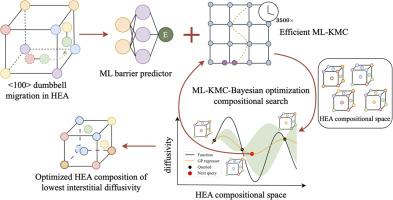基于机器学习-动力学蒙特卡罗和贝叶斯优化的FeNiCrCoCu高熵合金缓慢间隙扩散的有效成分探索
IF 2.9
Q2 MATERIALS SCIENCE, MULTIDISCIPLINARY
引用次数: 0
摘要
由于高熵合金(HEAs)的成分空间很大,对其缓慢扩散的研究仍未得到充分的探讨。特别是,自间隙扩散表现出非单调的成分依赖,需要有效的搜索来确定最佳成分。本文提出了三种基于动力学蒙特卡罗(KMC)的方法来模拟FeNiCrCoCu模型HEA系统中15种哑铃类型具有125种不同迁移路径的复杂< 100 >间隙哑铃扩散:传统KMC (C-KMC),随机抽样KMC (RS-KMC)和机器学习KMC (ML-KMC)。我们的研究结果表明,ML-KMC具有有效预测哑铃形成能量的能力,可以有效地捕获关键的扩散模式,并通过独立分子动力学(MD)模拟得到验证。ML-KMC方法为研究HEAs中复杂的哑铃扩散提供了一种有前途的高通量方法(比MD快3500倍)。本文还分析了快速扩散元素(Cr+Cu)的渗滤效应,认为HEAs中没有普遍的渗滤阈值。为了有效地探索成分空间并确定具有较慢间隙扩散率的HEA成分,ML-KMC集成在贝叶斯优化(BO)框架中。该方法仅在10次迭代中就成功地识别出了扩散系数比800 K下的等原子HEA慢一个数量级的HEA成分,避免了传统的强力成分枚举的低效率。通过独立的MD模拟进一步验证了所确定的最佳成分(Fe35Ni14Cr6Co35Cu10),验证了ML-KMC-BO方法的有效性。这项工作可以促进对成分依赖的扩散机制的理解,并为HEA设计提供有价值的见解。本文章由计算机程序翻译,如有差异,请以英文原文为准。

Efficient compositional exploration for sluggish interstitial diffusion in FeNiCrCoCu high-entropy alloys using machine learning-kinetic Monte Carlo and Bayesian optimization
The study of sluggish diffusion in high-entropy alloys (HEAs) remains underexplored largely due to their extensive compositional space. In particular, self-interstitial diffusion exhibits a non-monotonic compositional dependence, necessitating an efficient search to identify optimum compositions. This work presents three kinetic Monte Carlo (KMC)-based methods to simulate complex interstitial dumbbell diffusion of 15 dumbbell types with 125 distinct migration paths in a model FeNiCrCoCu HEA system over a large compositional space: conventional KMC (C-KMC), random-sampling KMC (RS-KMC), and machine learning KMC (ML-KMC). Our results demonstrate that ML-KMC, with its ability of efficiently predicting dumbbell formation energies on the fly, can effectively capture key diffusion patterns, as validated by independent molecular dynamics (MD) simulations. This ML-KMC method provides a promising high-throughput approach (about 3500 times faster than MD) for studying the complex dumbbell diffusion in HEAs. The controversial percolation effect by faster diffusing elements (Cr+Cu) is also analyzed, suggesting no universal percolation threshold in HEAs. To efficiently explore the compositional space and pinpoint HEA compositions with slower interstitial diffusivities, ML-KMC is integrated within a Bayesian optimization (BO) framework. This approach successfully identifies HEA compositions with diffusivities over an order of magnitude slower than the equiatomic HEA at 800 K within only a few ten iterations, circumventing the inefficiency of conventional brute-force compositional enumeration. The identified optimal composition (Fe35Ni14Cr6Co35Cu10) is further verified by independent MD simulations, confirming the effectiveness of the ML-KMC-BO methodology. This work can advance the understanding of compositional-dependent diffusion mechanisms and provide valuable insights for HEA design.
求助全文
通过发布文献求助,成功后即可免费获取论文全文。
去求助
来源期刊

Materialia
MATERIALS SCIENCE, MULTIDISCIPLINARY-
CiteScore
6.40
自引率
2.90%
发文量
345
审稿时长
36 days
期刊介绍:
Materialia is a multidisciplinary journal of materials science and engineering that publishes original peer-reviewed research articles. Articles in Materialia advance the understanding of the relationship between processing, structure, property, and function of materials.
Materialia publishes full-length research articles, review articles, and letters (short communications). In addition to receiving direct submissions, Materialia also accepts transfers from Acta Materialia, Inc. partner journals. Materialia offers authors the choice to publish on an open access model (with author fee), or on a subscription model (with no author fee).
 求助内容:
求助内容: 应助结果提醒方式:
应助结果提醒方式:


